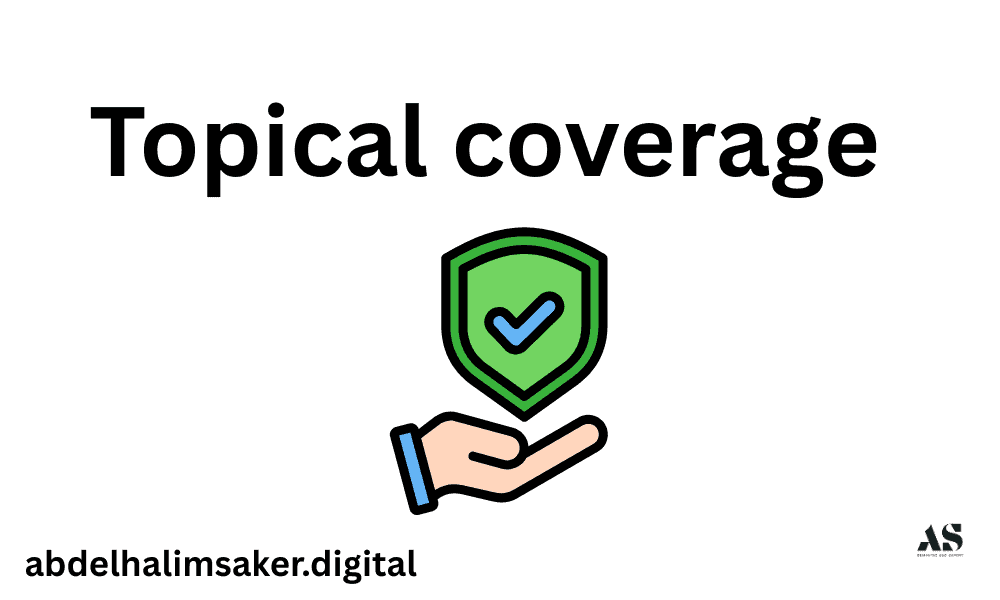
Topical Coverage is the scope and depth of contextual completeness that a website achieves within a topic cluster. It defines how thoroughly a brand, author, or publisher addresses all semantically related entities, attributes, and subtopics connected to a specific subject.
In semantic SEO, topical coverage is not about keyword quantity — it’s about meaning density, entity relationships, and contextual balance. Search engines measure how well your content represents a topic’s semantic universe.
When a site reaches high topical coverage, Google’s algorithms classify it as a trusted entity source within that domain. This boosts visibility, recall, and retrieval efficiency for all related queries.
Why Topical Coverage Determines Relevance
How does coverage define relevance in search?
Relevance in semantic search depends on contextual completeness. When content covers every significant aspect of a topic, it forms a semantic field that mirrors how humans understand meaning.
Coverage = Semantic Context → Improved Recall
| Concept | Description | Example |
|---|---|---|
| Semantic Context | The network of entities and attributes around a topic | “Topical Coverage” connects to “Topical Authority,” “Semantic SEO,” “Entity SEO” |
| Information Recall | Search engine’s ability to retrieve related results | A page with full coverage ranks for multiple related queries |
The equation is simple:
Broader and coherent topical coverage → richer semantic context → higher retrieval probability.
This relationship is central to Google’s shift from keyword retrieval to entity-based recall. When Google identifies a domain as semantically complete on a subject, it uses it more often to satisfy similar future queries — a process known as predictive information retrieval.
Thus, topical coverage doesn’t just determine ranking — it determines retrieval eligibility.
Core and Peripheral Contexts in Topical Coverage
How should coverage be structured for maximum semantic gain?
Topical coverage follows a core–peripheral model. The core context represents the essential meaning unit of a topic, while the peripheral context builds contextual diversity and user interaction potential.
This dual-layer approach prevents semantic isolation — when content exists in a vacuum without contextual bridges.
How Core Topics Establish Expertise
The core section anchors the main entity and its defining attributes. It answers what, how, and why questions directly linked to the entity.
| Core Element | Function | Example Query |
|---|---|---|
| Primary Entity | The main concept defining the cluster | “What is Topical Coverage?” |
| Attributes | Features or measurable qualities | “Depth of coverage,” “semantic completeness,” “contextual density” |
| Processes | Methods that shape the entity’s behavior | “How to measure topical coverage” |
| Comparisons | Differentiating related entities | “Topical Coverage vs Topical Authority” |
By defining and interlinking these, Google infers that your content represents subject-matter expertise.
A strong core page links to related concept pages (e.g., Semantic SEO, Entity Optimization, Knowledge Graphs), creating semantic consolidation.
How Outer Topics Build Historical Data and Engagement
The outer section expands context through related informational and supportive subtopics. These create semantic variation while maintaining proximity to the core.
Outer topics may include:
- “Entity-based content modeling”
- “NLP metrics for topical analysis”
- “Schema markup and context vectors”
Each reinforces the parent entity and adds behavioral validation through diverse entry points.
Example:
- A user searching for “entity extraction for SEO” lands on a subtopic page.
- The user then clicks to “Topical Coverage” → Google logs this query path reinforcement.
That behavioral data strengthens the site’s authority vector for the topic cluster.
Thus, outer content acts as a context amplifier and a historical data builder, both of which enhance Google’s entity memory for your domain.
Measuring Topical Coverage
How can you measure whether coverage is complete?
Topical coverage can be analyzed through linguistic, statistical, and structural methods using NLP and data clustering tools.
1. Entity Extraction
Extract all entities (nouns, concepts, brands, people, places) appearing in your content.
Tools:
- Google NLP API
- spaCy
- InLinks Entity Analyzer
- TextRazor
Compare your entity list to competitors’ pages or Wikipedia category pages. Missing entities indicate coverage gaps.
Example:
If your topic is “Semantic SEO” but your site omits entities like Hummingbird, RankBrain, MUM, or Knowledge Graph, your topical coverage is incomplete.
2. N-gram Distribution
Analyze bigrams and trigrams to find recurring contextual phrases.
- Balanced n-gram distribution → semantic coherence
- Over-repeated single terms → lexical optimization (not semantic)
Ideal topical coverage shows diverse but relevant n-grams, forming a rich context web.
3. Semantic Clustering
Group pages or paragraphs by semantic similarity.
Use embeddings from tools like BERT, Word2Vec, or OpenAI’s embeddings to visualize topic clusters.
Clusters with weak connectivity indicate missing context bridges.
Metric Example:
- Core cluster density score: 0.92
- Peripheral cluster diversity: 0.75
- Intercluster distance: <0.2 → Optimal semantic unity
Expanding Topical Coverage Strategically
How can you broaden coverage without losing topical focus?
Expanding coverage requires maintaining contextual borders while adding semantic bridges — a core principle in Koray’s attribute filtration model.
1. Define Contextual Borders
Contextual borders determine what belongs inside or outside your topic cluster.
For example:
- “Topical Coverage” includes semantic clustering and contextual completeness.
- It does not include general SEO basics or paid search ads.
Using attribute filtration, you keep only attributes that directly modify the central entity.
If “X does not change the meaning of Y,” then X lies outside the border.
2. Create Contextual Bridges
Contextual bridges connect semantically adjacent topics to the main cluster. They create meaning flow between sub-entities.
Example bridges for “Topical Coverage”:
- Topical Coverage → supports → Topical Authority
- Topical Coverage → relies on → Entity Co-occurrence
- Topical Coverage → improves → Semantic Indexing
Each bridge expands the semantic graph without diluting focus.
3. Prioritize Coverage by Query Demand
Use search intent mapping to prioritize which subtopics to add.
- Informational: “What is topical coverage?”
- Operational: “How to measure coverage in SEO?”
- Comparative: “Topical coverage vs topical depth.”
Addressing each query type ensures multi-dimensional coverage and aligns with Google’s multi-intent retrieval systems (MUM, RankBrain).
4. Temporal Expansion: Momentum and Update Cycles
Coverage grows over time through publication velocity and update frequency.
Google interprets consistent updates as ongoing learning, rewarding the site with stronger temporal authority vectors.
Example schedule:
- Week 1–4: Core pages
- Week 5–8: Supporting entities
- Week 9+: Updates and schema enhancements
Real Examples of Coverage Gaps
What happens when coverage is incomplete?
Coverage gaps reduce semantic relevance, fragment entity graphs, and lower retrieval confidence. Below are practical scenarios.
Example 1: Missing Core Entities
| Topic | Missing Entities | Result |
|---|---|---|
| Semantic SEO | RankBrain, MUM, Hummingbird | Google misreads context as lexical SEO |
| Topical Coverage | Contextual bridges, EAV model | Incomplete semantic field |
| Entity SEO | Knowledge Graph, schema markup | Entity connections remain weak |
Without these elements, Google cannot confirm contextual completeness, and rankings remain unstable.
Example 2: Overlapping but Disconnected Subtopics
When subtopics exist without interlinks, Google fails to recognize cluster unity.
For instance, having separate pages on:
- “Entity Extraction in SEO”
- “Topical Maps for Content Strategy”
without linking them to “Topical Coverage” breaks the semantic bridge, lowering topical density.
Example 3: Uneven Attribute Depth
If one attribute (e.g., entity recognition) is deeply covered while another (e.g., semantic clustering) is shallow, the coverage becomes imbalanced.
Balanced coverage improves information gain, a metric Google uses to evaluate knowledge depth.
Example 4: Excessive Lexical Optimization
Focusing on repeating keywords like “topical coverage SEO” without semantic diversity signals lexical redundancy.
Semantic algorithms like BERT penalize this pattern because it lacks conceptual richness.
Example 5: Unstructured Internal Linking
If contextually related pages are linked randomly or not at all, semantic signals become isolated.
A structured, entity-based linking system forms predictable semantic paths, which Google uses to infer meaning.
Related Semantic Dimensions of Topical Coverage
Which advanced concepts enhance understanding of topical coverage?
- Topical Authority: Represents the trust and validation built through complete topical coverage.
- Context Vectors: Define semantic directionality in how topics connect.
- Entity Consolidation: Merges similar or synonymous entities to prevent topical fragmentation.
- Contextual Hierarchies: Organize subtopics into core, related, and supportive layers.
- Information Gain Value (IGV): Measures unique informational contribution per page within the cluster.
These elements form the semantic scaffolding behind effective topical coverage and ensure alignment with Google’s Knowledge Graph indexing logic.
How Topical Coverage Interacts with Other Semantic Systems
Topical coverage interacts with Topical Authority, Semantic SEO, and Entity-Based Optimization.
| Relationship | Description | SEO Impact |
|---|---|---|
| Topical Coverage → enables → Topical Authority | Full coverage validates expertise | Improves ranking consistency |
| Topical Coverage → supports → Semantic SEO | Provides entity-rich context | Enhances semantic recall |
| Topical Coverage → strengthens → Knowledge Graph links | Improves entity disambiguation | Boosts brand recognition |
These interconnections create a coherent semantic network, increasing retrieval probability and content stability across updates.
Practical Workflow for Building Complete Topical Coverage
Step-by-step approach based on Koray’s methodology:
- Identify Central Entity: Define the main concept and its defining attributes.
- Extract Co-occurring Entities: Use NLP tools to list supporting concepts.
- Map Relationships: Visualize entity links using graph software (e.g., Neo4j, InLinks).
- Segment Core vs Peripheral: Create page hierarchies accordingly.
- Write for Information Gain: Ensure each page adds unique, non-redundant context.
- Implement Contextual Linking: Use descriptive anchor text for entity relations.
- Add Structured Data: Mark up entities for machine understanding.
- Monitor Entity Coverage Metrics: Use Search Console, Semrush, and NLP APIs.
The Role of Topical Coverage in Predictive Information Retrieval
Why is coverage central to Google’s retrieval logic?
Predictive Information Retrieval (PIR) assumes that if a site fully covers a topic, it can predictably satisfy future semantically related queries.
Thus, Google pre-ranks such sites in relevant query spaces, lowering retrieval costs.
The process looks like this:
High topical coverage → semantic completeness → retrieval certainty → predictive ranking advantage.
This explains why websites with broad, coherent coverage maintain stable rankings across algorithm updates.
